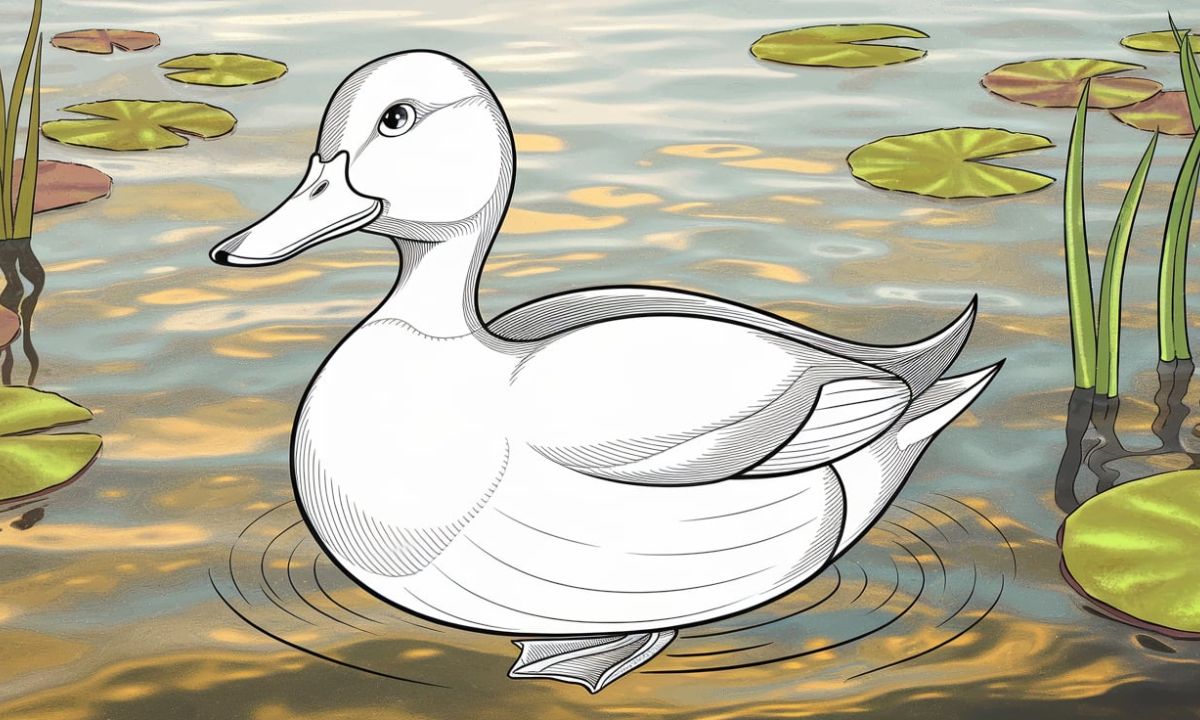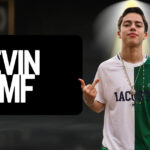Drawing ducks can be a delightful artistic adventure for artists of all skill levels. From adorable ducklings to cool ducks sporting sunglasses, these feathered friends offer endless creative possibilities. This comprehensive guide presents 30 easy duck drawing ideas that anyone can try, regardless of artistic experience.
Whether you’re looking for simple duck doodles to practice your skills or cute duck drawings to brighten someone’s day, this collection has something for everyone.
Duckling on a Slice of Bread
One of the most charming easy duck drawing ideas is a tiny duckling perched atop a slice of bread. This adorable combination brings together two simple shapes that beginners can master quickly.
Start with an oval for the duckling’s body and a smaller circle for its head. Add a triangular beak, dot eyes, and tiny wings. For the bread, draw a rounded rectangle beneath the duckling with some texture lines to represent the bread’s surface.
This drawing concept works wonderfully because:
- It combines basic shapes (circles, ovals, and rectangles)
- The contrast between the soft duckling and structured bread creates visual interest
- The unusual pairing creates an instantly memorable image
Pro Tip: Use yellow and brown colored pencils to bring this cute duck drawing to life, adding warmth and dimension to your artwork.
A Chubby Duck
Chubby duck sketches radiate irresistible charm with their rounded forms and huggable appearance. To create a plump duck illustration, focus on exaggerating the roundness of the body while keeping the legs and feet proportionally small. This contrast emphasizes the duck’s adorable chubbiness.
For the perfect chubby duck sketch:
- Start with an extra-large oval for the body
- Add a round head that blends into the body with minimal neck
- Draw tiny wings that seem almost too small for the rotund body
- Include short, stubby legs and feet
- Add a small bill and round eyes for maximum cuteness
The key to successful chubby duck drawings lies in the proportions. Make the body substantially larger than a regular duck would be, creating that delightful pudgy appearance that makes viewers want to reach out and squeeze it!
Some Innocent Duck
Capturing innocence in duck character design involves specific artistic choices that convey purity and sweetness. For an innocent duck drawing, focus on creating large, round eyes with small pupils and an upturned beak that resembles a smile. This facial structure naturally evokes feelings of innocence and trustworthiness.
To enhance the innocent quality of your duck:
- Position the head slightly tilted to one side
- Add soft, fluffy feather details around the neck and head
- Keep the body posture open and relaxed
- Use gentle curves rather than sharp angles throughout
This drawing style works perfectly for greeting cards, children’s book illustrations, or any project requiring a wholesome, gentle character. The innocent duck serves as an excellent starting point for beginners in kawaii duck art, teaching fundamental techniques for conveying emotion through simplified forms.
Duck Wearing a Hoodie
Dressed-up duck drawings add personality and contemporary flair to your artwork. A duck wearing a hoodie combines the natural charm of waterfowl with human fashion elements, creating an instantly engaging character. This trendy duck art concept allows for endless customization options with different hoodie styles, colors, and accessories.
To create a duck wearing a hoodie:
- Draw your basic duck shape first
- Add a hoodie that frames the face, with the hood either up or down
- Include details like drawstrings, pockets, and fabric texture
- Consider adding logos, patterns, or text on the hoodie for personalization
- Ensure the hoodie follows the duck’s body contours for a natural look
This stylish duck drawing works wonderfully for character development, teaching artists how to blend animal and human elements seamlessly. The contrast between the duck’s natural features and the manufactured clothing creates visual interest and storytelling opportunities.
| Hoodie Style | Character Vibe | Best Colors |
| Oversized | Cozy, relaxed | Pastels, neutrals |
| Athletic | Sporty, energetic | Primary colors, team colors |
| Zip-up | Practical, versatile | Earth tones, blacks, grays |
| Cropped | Fashion-forward, trendy | Bright, bold colors |
| Graphic | Expressive, statement-making | Any color with contrasting graphics |
Cute Simple Duck
Sometimes the most charming duck illustrations come from the simplest approaches. A cute simple duck doodle relies on clean lines and minimal details to create an instantly recognizable and appealing character. This minimalist duck art style is perfect for beginners developing their fundamental drawing skills.
Essential elements for a simple duck drawing include:
- A rounded body shape
- A clearly defined head
- A distinctive bill
- Small wings indicated with just a few lines
- Basic webbed feet
- Simple dot eyes or slightly more detailed eyes with pupils
The beauty of simple duck doodles lies in their versatility. Once you master the basic form, you can quickly replicate it in different positions and scenarios, building a collection of duck illustrations with minimal effort.
“Simplicity is the ultimate sophistication.” – Leonardo da Vinci
This quote perfectly captures the appeal of simple duck art. By reducing the subject to its essential elements, you create a clean, powerful image that communicates effectively without unnecessary complexity.
Fed Up Duck
The grumpy duck drawing presents a humorous contrast to the typically cheerful duck depictions. A fed up duck illustration captures that universally recognizable moment of exasperation, creating an instantly relatable character. This moody bird sketch teaches artists how to convey complex emotions through subtle adjustments to the basic duck form.
To create the perfect fed up duck:
- Draw slightly narrowed eyes with heavy lids
- Position the bill in a downturned expression
- Add furrowed brows (or the duck equivalent)
- Create a slouched posture with dropped wings
- Consider adding visual cues like crossed wings or tapping feet
Frustrated duck art offers excellent practice in character expression. The contrast between the duck’s naturally cute appearance and the annoyed expression creates humor through juxtaposition. These sassy duck drawings make perfect reaction images, emojis, or greeting cards for those days when everything seems to go wrong.
Duck Holding a Flower
A duck with a flower creates a gentle, whimsical image that balances natural elements beautifully. This flower-carrying bird concept works wonderfully for spring-themed illustrations, Mother’s Day cards, or any project requiring a touch of sweetness. The floral duck sketch combines the structural simplicity of the duck with the organic complexity of the flower.
For a charming duck holding a flower:
- Position the flower either in the duck’s bill or held by a wing
- Choose a simple flower like a daisy or tulip for beginners
- Ensure the flower’s size complements the duck without overwhelming it
- Consider adding small details like fallen petals or leaves
- Use contrasting colors to make both elements pop
This nature-inspired duck art teaches valuable lessons about composition and the symbolic meaning objects can bring to a drawing. The flower suggests gentleness, care, and appreciation—qualities that transform a simple duck drawing into a meaningful visual message.
Duck Laying Down
Depicting a duck in a restful position creates a peaceful, calming image while offering artists practice with different angles and perspectives. For easy bird drawing ideas, a duck laying down provides an accessible entry point to more complex posing techniques.
To create a convincing duck in repose:
- Draw the duck’s body as an elongated oval, parallel to the ground
- Position the head either resting on the surface or slightly raised
- Tuck the wings close to the body
- Arrange the webbed feet in a natural relaxed position
- Add subtle details like closed or half-lidded eyes
This pose works wonderfully for depicting sleepy ducks, sunbathing ducks, or simply ducks taking a moment of rest. The horizontal composition creates a sense of stability and calm, making it perfect for peaceful scenes or bedtime illustrations.
Duck Listening to Music
Modernize your duck character design with headphones and musical elements! A duck listening to music combines traditional animal drawing with contemporary culture, creating an instantly relatable and engaging image. This trendy duckling concept allows for storytelling through visual cues—what kind of music is this duck enjoying? How does it make them feel?
For a duck jamming to tunes:
- Add headphones that fit the duck’s head anatomy
- Consider the duck’s expression—are they lost in the music? Dancing? Relaxed?
- Include visual music cues like notes or sound waves
- Position the body in a way that suggests rhythm or movement
- Consider adding related technology like a smartphone or MP3 player
This drawing concept teaches artists to blend natural elements with manufactured objects, creating a harmonious composition that tells a story through visual means alone.
Duck’s Face, Tongue Out
Close-up portraits offer excellent practice in facial expression and detail work. A duck’s face with tongue out creates an instantly playful, slightly silly character that captures attention. This expressive duck drawing focuses on facial features while teaching valuable lessons about capturing personality through minimal means.
To create this playful expression:
- Draw a close-up view of the duck’s face, filling most of your page
- Create a slightly open bill with the tongue visible
- Position the eyes to enhance the playful mood (perhaps slightly crossed or wide)
- Add small details like feather texture around the face
- Consider the angle—a slight tilt adds to the whimsical feel
This drawing concept works wonderfully for emoji designs, cartoon characters, or any project requiring a touch of humor. The focused composition eliminates background distractions, allowing viewers to connect directly with the duck’s personality.
Angry Duck
Few things are as amusingly contradictory as a furious duck. The angry duck cartoon combines the naturally cute appearance of ducks with expressions of rage, creating humor through contrast. This raging duck doodle teaches valuable lessons about expressing emotion through posture, facial expression, and symbolic visual elements.
For a convincingly angry duck:
- Draw downturned or V-shaped eyebrows
- Create a wide-open bill as if quacking loudly
- Position the wings outstretched or akimbo
- Add visual anger cues like steam, red face coloring, or motion lines
- Consider an aggressive stance with the body leaning forward
The aggressive duck drawing works wonderfully for comic situations, reaction images, or character development. The contrast between the duck’s typically gentle appearance and the expression of rage creates inherent humor that resonates with viewers.
Duck Swimming in Water
Depicting ducks in their natural habitat creates immediately recognizable and contextually rich illustrations. A floating duck drawing incorporates both the animal subject and environmental elements, teaching valuable lessons about suggesting water and movement through simple visual techniques.
To create a duck swimming:
- Draw just the upper portion of the duck visible above a horizontal line
- Add wavy lines to represent water
- Include ripples emanating from where the duck’s body meets the water
- Consider adding environmental elements like reeds, lilies, or other pond life
- Use the duck’s reflection for added realism and visual interest
This waterfowl sketch challenges artists to suggest an entire environment with minimal means. The wavy water duck concept works beautifully for nature scenes, bathroom décor, or any project celebrating ducks in their natural element.
Wavy Water Techniques:
| Water Condition | Line Type | Additional Elements |
| Calm | Gentle, widely spaced waves | Clear reflections |
| Slightly rippled | Small, close wavelets | Partial, distorted reflections |
| Choppy | Sharp, irregular waves | Splashes, white caps |
| Rainy | Circular ripple patterns | Droplet impacts, overlapping circles |
Simple Duck
Mastering the basic duck form provides a foundation for all other duck drawings. The quick duck sketch focuses on capturing the essential elements that make a duck recognizable—oval body, distinct head and bill shape, and characteristic posture. This beginner-friendly duck outline serves as the starting point for more complex duck illustrations.
Essential elements of a basic duck outline:
- Oval or egg-shaped body
- Round head with distinctive bill
- Simple wing indication
- Webbed feet
- Tail feathers
- Eye placement
This minimalist duck art teaches fundamental shape recognition and proportion. Once artists master this basic form, they can elaborate with details, expressions, and poses to create more complex duck characterizations.
“Learn the rules like a pro, so you can break them like an artist.” – Pablo Picasso
This approach applies perfectly to duck drawing—understanding the basic structure allows for creative interpretation and stylization later.
Cute Rubber Duck
The iconic bath duck represents a specific subset of duck illustrations with distinctive characteristics. A toy duck drawing focuses on the manufactured rather than natural duck form, featuring smoother lines, simplified features, and often a bright yellow color. The childhood duck doodle evokes nostalgia while offering practice in creating shiny, manufactured-looking surfaces.
For an authentic rubber duck illustration:
- Create a rounded body with minimal texture
- Draw a flat-bottomed base for stability
- Add the characteristic bill in orange
- Include simple dot eyes
- Keep details minimal for that mass-produced toy look
- Add shine spots to suggest the plastic surface
This floating rubber duck concept works wonderfully for bathroom-themed illustrations, childhood memories, or any project requiring a touch of playful nostalgia. The plastic duck art style teaches valuable lessons about suggesting different materials through visual cues.
Another Chubby Duck
Revisiting the plump duck illustration from a different angle offers new drawing challenges and opportunities. This round duck drawing might show the chubby duck from the front, emphasizing the full roundness of the belly and chest. The fat duck doodle celebrates the adorable qualities of rotundity while teaching valuable lessons about creating volume through line and shadow.
To enhance the chubby appearance from a new angle:
- Emphasize the width of the body from a frontal view
- Create folds or divisions where fat would naturally accumulate
- Make the head appear proportionally smaller
- Add tiny feet that seem barely capable of supporting the rounded body
- Consider a slight lean or tilt that suggests the duck’s weight affects its balance
This soft duck art style appeals to our natural affinity for rounded, baby-like forms. The cartoon duckling’s exaggerated proportions create an instantly endearing character that viewers connect with emotionally.
Cute Duckling with Phone
Combining baby duck art with modern technology creates a charming juxtaposition. The tiny duck sketches holding modern devices like smartphones reflect our contemporary digital culture while maintaining the inherent cuteness of ducklings. This modern twist on duck character design offers opportunities for storytelling and humor.
For a duckling with a phone:
- Draw a small, fluffy duckling with characteristic baby proportions
- Add a smartphone scaled to the duckling’s size
- Position the wings/wings as if holding the device
- Consider the duckling’s expression—absorbed, confused, or delighted
- Add details like screen glow or app icons for realism
This contemporary duck illustration concept works wonderfully for tech-related content, social media commentary, or any project blending natural and digital worlds. The charming duck illustrations gain relevance through their interaction with familiar technology.
Curious Duck
Capturing curiosity requires specific artistic choices that convey interest and attention. A curious duck drawing typically features a tilted head, wide eyes, and forward-leaning posture that suggests engagement with something intriguing. This bird sketch teaches valuable lessons about conveying complex emotions through simple adjustments to the basic duck form.
To create a convincingly curious duck:
- Tilt the head at a distinct angle
- Make the eyes wider than normal, with pupils focused on a point of interest
- Position the body leaning slightly forward
- Consider adding an object of curiosity in the composition
- Use the bill position to enhance the expression of interest
This drawing concept works beautifully for storytelling, as it naturally suggests a narrative—what has caught this duck’s attention? The expression creates immediate engagement with viewers, who become curious themselves about what the duck might be observing.
Ducklings Relaxing
Group compositions present unique challenges and opportunities for artists. Fluffy duck doodles of multiple ducklings relaxing together create a peaceful, harmonious scene while teaching valuable lessons about arrangement, overlap, and creating variety within a cohesive group.
For a scene of relaxing ducklings:
- Create 3-5 duckling forms in various restful poses
- Vary their positions—some sleeping, some preening, some simply sitting
- Arrange them in a natural grouping, with some overlap for depth
- Maintain consistent proportions while introducing subtle variations
- Add minimal environmental elements like grass or water
This drawing concept teaches composition skills and the art of creating visual rhythm through repetition with variation. The duck chick illustrations gain emotional impact through their group dynamic, suggesting community and safety.
Duckling Grouping Techniques:
| Group Type | Emotional Effect | Best Arrangement |
| Tight huddle | Security, warmth | Circular, overlapping |
| Scattered | Playfulness, exploration | Asymmetrical, varied distances |
| Line formation | Order, following | Sequential, evenly spaced |
| Pairs | Companionship, friendship | Duos with interaction |
| Sleeping pile | Ultimate comfort, trust | Random, organic stacking |
Duck with Sunglasses
Cool duck drawings add attitude and personality through simple accessories. A stylish bird sporting sunglasses immediately takes on a confident, laid-back character that breaks from the typical duck depiction. This trendy duckling concept teaches the power of accessories in character development.
For the perfect sunbathing duck:
- Position sunglasses appropriately on the duck’s face, accounting for bill placement
- Choose a sunglasses style that reflects the character you want to convey
- Consider the duck’s posture—relaxed, strutting, or posed
- Add complementary accessories like a sun hat or beach towel for context
- Use the duck’s expression to enhance the cool, relaxed vibe
This relaxed duck doodle works wonderfully for summer-themed illustrations, vacation content, or any project requiring a touch of attitude. The sunglasses transform the simple duck into a character with implied personality and lifestyle.
Angry Duck Laying
Combining pose and emotion creates complex, interesting characters. An angry duck that’s lying down presents a contradictory image—the relaxed posture contrasts with the intense emotion, creating visual interest through juxtaposition. This feisty duck character teaches artists how to maintain emotional expression regardless of the body’s position.
To create an angry duck in a horizontal position:
- Draw the duck’s body in a laying position, parallel to the ground
- Maintain angry facial features—furrowed brows, narrowed eyes, open bill
- Position the wings to suggest tension despite the horizontal pose
- Consider adding visual anger cues like steam or motion lines
- Create tension in the normally relaxed laying position
This drawing challenges artists to convey two seemingly contradictory states simultaneously—rest and rage. The result creates storytelling opportunities and character depth beyond simpler duck depictions.
Cute Duck’s Face
Close-up portraits of adorable ducks focus attention on the most expressive features. Charming duck illustrations that zoom in on just the face create immediate emotional connection while teaching valuable lessons about facial proportion and expression. This kawaii duck art style emphasizes the eyes and bill as primary carriers of character and emotion.
For an appealing duck face portrait:
- Fill most of your drawing space with just the face
- Emphasize the eyes—make them slightly larger for cuteness
- Pay attention to the curve and shape of the bill
- Add subtle feather texture around the face for dimension
- Consider the head angle—a slight tilt often enhances cuteness
This focused approach works wonderfully for emoji design, avatar creation, or any project requiring strong emotional impact in a small space. The duck character design gains power through the elimination of distracting elements.
Duck Crying
Expressing sadness through duck illustrations creates immediately empathetic characters. A crying duck drawing uses specific visual elements to convey emotion—downturned eyes, tears, drooping posture, and perhaps a slightly open bill suggesting a sad sound. This emotional duck art teaches artists how to evoke specific feelings through visual cues.
To create a convincingly sad duck:
- Draw downturned eyes with heavy upper lids
- Add tear droplets falling from the eyes
- Position the bill slightly open and downturned
- Create a slumped, drooping body posture
- Consider adding environmental elements that enhance the mood, like rain
This drawing concept works powerfully for emotional storytelling, sympathy cards, or any project requiring an expression of sadness. The contrast between the typically cheerful duck form and the expression of sorrow creates immediate emotional impact.
Happy Duck
Joyful duck illustrations radiate positive energy through specific artistic choices. For quick duck sketches conveying happiness, focus on upturned eyes, slightly open bill suggesting a smile, and energetic body posture. This cheerful bird drawing teaches artists how to convey positive emotions effectively.
For an authentically happy duck:
- Create upturned eyes, perhaps with small crinkles at the corners
- Position the bill slightly open in a smile-like expression
- Raise the wings slightly as if about to flap with excitement
- Lift the body posture, perhaps with the duck slightly on tiptoes
- Add motion lines to suggest movement and energy
This drawing concept works wonderfully for celebration cards, motivational content, or any project requiring a burst of positivity. The happy duck serves as an immediately recognizable symbol of joy that communicates effectively across cultures.
Duck’s Emblem
Stylized duck art reduces the form to its most essential elements, creating iconic representations that work at various scales. A duck emblem design focuses on creating a balanced, symmetrical, and instantly recognizable duck silhouette that could function as a logo or symbol. This minimalist duck art teaches valuable lessons about simplification while maintaining recognizability.
For an effective duck emblem:
- Reduce the duck to its most basic outline
- Ensure the silhouette is instantly recognizable as a duck
- Create balance and symmetry where appropriate
- Consider negative space as an active design element
- Test the design at various sizes to ensure scalability
This approach works wonderfully for logo design, branding projects, or any application requiring a simplified duck representation. The duck emblem serves as an exercise in identifying the most essential elements that communicate “duck” to viewers.
Duck in a Pool of Tears
Surreal and emotional duck illustrations combine literal and figurative elements to create powerful images. A duck floating in its own tears presents a visually striking and emotionally resonant scene that blends reality and metaphor. This concept teaches artists how to visually represent emotional states through environmental elements.
To create this evocative scene:
- Draw a duck floating on a small pool of water
- Add teardrops falling from the duck’s eyes into the pool
- Create ripples where the tears impact the water surface
- Consider the duck’s expression—sad, overwhelmed, or resigned
- Use the composition to emphasize the emotional tone
This drawing concept works beautifully for expressing complex emotional states, illustrating stories or poems, or creating visually striking metaphorical images. The ripple effect duck art gains power through its symbolic representation of emotional overwhelm.
Psyduck Crying
Character-specific duck drawings allow artists to explore established designs while adding their own interpretive elements. The Pokémon character Psyduck, known for its constant headaches, offers a recognizable base for emotional expression. Drawing Psyduck crying combines fan art with emotional storytelling.
For a convincing crying Psyduck:
- Start with the basic Psyduck character design—round yellow body, bill, and round head
- Add the characteristic hands holding the head in pain
- Create tears flowing from the eyes
- Exaggerate the pained expression with downturned eyes and bill
- Consider adding symbolic elements like question marks or stars to suggest confusion
This drawing concept appeals particularly to Pokémon fans while teaching valuable lessons about working within established character design parameters. The emotional state adds narrative interest to the familiar character.
Cute Duck with a Knife
Juxtaposition creates immediate visual interest and humor. A cute duck holding a knife combines innocence and potential danger, creating an unexpected and memorable image. This contradictory pairing teaches artists about creating humor and interest through unexpected combinations.
For this surprising combination:
- Draw an exceptionally cute, innocent-looking duck with large eyes
- Add a knife held in one wing (keep it simple and recognizable as a knife)
- Maintain the duck’s sweet, innocent expression for maximum contrast
- Consider the duck’s body language—casual, threatening, or confused
- Use composition to emphasize the unexpected pairing
This concept works wonderfully for humor, memes, or any project requiring unexpected visual juxtaposition. The contrast between the cute duck and the threatening object creates immediate visual interest and memorability.
Another Simple Duck
Revisiting the basic duck form from a different angle or with slight variations reinforces fundamental drawing skills. This beginner-friendly duck approach focuses on creating another variation of the simple duck, perhaps from a different angle or with minimal stylistic changes. This easy bird drawing concept teaches artists how versatile even the most basic form can be.
To create a variation on the simple duck:
- Start with the basic duck structure you’ve already learned
- Change the viewing angle—perhaps a 3/4 view instead of profile
- Make minor adjustments to proportions or feature placement
- Keep details minimal but recognizable
- Consider a slightly different posture or head position
This drawing reinforces basic skills while introducing subtle variations that build confidence and versatility. The quick duck sketch serves as practice in maintaining consistency while introducing controlled variation.
Meh Duck
Capturing indifference requires subtlety and restraint. A “meh” duck expresses boredom or lack of interest through specific visual cues—half-lidded eyes, neutral bill position, and relaxed or slightly slouched posture. This expressionless bird teaches artists how to convey the absence of strong emotion—often more challenging than expressing obvious feelings.
For a convincingly indifferent duck:
- Draw eyes half-closed or with heavy lids
- Position the bill in a neutral, neither up nor down position
- Create a relaxed body posture without energy or tension
- Consider adding visual cues like a small shrug or flat line mouth
- Use the duck’s gaze to enhance the feeling of disinterest
This drawing concept works wonderfully for humor, reaction images, or any project requiring an expression of neutrality or boredom. The “meh” duck offers a relatable character for those moments when enthusiasm simply isn’t available.
Very Demure Duck
Shyness and modesty create immediately endearing characters. A demure duck features specific visual elements that convey bashfulness—downcast eyes, wings positioned as if hiding the face, and a slightly hunched or protective posture. This duck character design teaches artists how to convey complex emotional states through subtle body language.
To create a convincingly demure duck:
- Position the head slightly downturned
- Create downcast eyes that avoid direct “gaze”
- Use one wing to partially cover the face or bill
- Create a slightly protective body posture
- Consider adding a blush effect for enhanced shyness
This drawing concept works beautifully for character development, storytelling, or any project requiring an expression of modesty or shyness. The demure duck creates immediate emotional engagement through its vulnerable presentation.
Wrap Up
These 30 easy duck drawing ideas provide endless inspiration for artists of all levels. From simple duck doodles to more complex character concepts, ducks offer a versatile subject that balances simplicity and expression perfectly. The adorable duck sketches outlined above serve as starting points for your own creative exploration.










